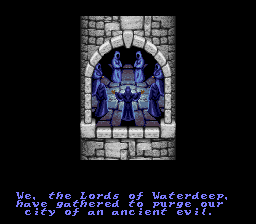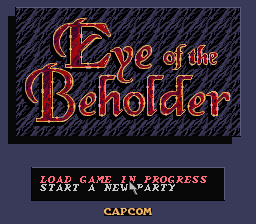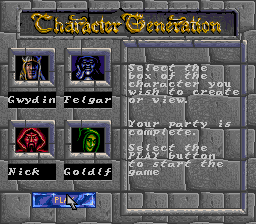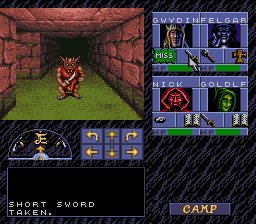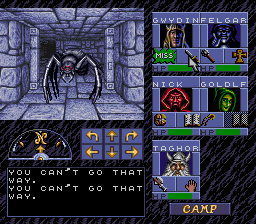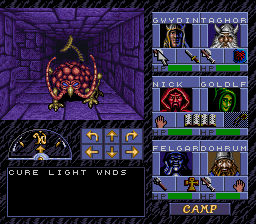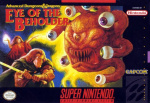Difference between revisions of "Eye of the Beholder (SNES)"
m (→Recording) |
m |
||
| (One intermediate revision by the same user not shown) | |||
| Line 16: | Line 16: | ||
The game is broken up into several screens. The top-left is a first-person view of what the party sees in front of them, and the player uses the cursor to interact with the environment. To the right of that is a portrait of each party member and the items they have in each hand. These are usually equipped with weapons, spellbooks, and holy symbols to combat enemies. Underneath the first-person view is a compass and directional arrows, the latter of which is used to move when clicked with the cursor. Alternatively, the player can use the D-pad to move as well. Underneath that is a text box, describing various things that happen in the game. On the bottom right is the Encamp button where the party can rest, memorize spells, and various game settings can be changed. | The game is broken up into several screens. The top-left is a first-person view of what the party sees in front of them, and the player uses the cursor to interact with the environment. To the right of that is a portrait of each party member and the items they have in each hand. These are usually equipped with weapons, spellbooks, and holy symbols to combat enemies. Underneath the first-person view is a compass and directional arrows, the latter of which is used to move when clicked with the cursor. Alternatively, the player can use the D-pad to move as well. Underneath that is a text box, describing various things that happen in the game. On the bottom right is the Encamp button where the party can rest, memorize spells, and various game settings can be changed. | ||
| − | The SNES is a considerable downgrade from the DOS version, as the resolution had to be downscaled, making the interface more cramped. As a result, each party member's name is limited to just six characters. The SNES version also suffers the same fate as the NES version of ''Pool of Radiance'', where Nintendo's censorship took effect; instead of ''praying'' for spells for clerics, they ''petition'' for spells. Spells like ''Bless'' have been renamed to ''Empower'', and references to "death" are changed to "fear". The game allows the player to take advantage of the SNES mouse, but this means they must tediously click the directional arrows to move. | + | The SNES is a considerable downgrade from the DOS version, as the resolution had to be downscaled, making the interface more cramped. As a result, each party member's name is limited to just six characters. The SNES version also suffers the same fate as the NES version of ''Pool of Radiance'', where Nintendo's censorship took effect; instead of ''praying'' for spells for clerics, they ''petition'' for spells. Spells like ''Bless'' have been renamed to ''Empower'', ''Prayer'' became ''Meditation'', and references to "death" are changed to "fear". The game allows the player to take advantage of the SNES mouse, but this means they must tediously click the directional arrows to move. |
The SNES version of the game received mixed reviews. While some of the graphics ''did'' receive an upgrade, many criticized the game for running too sluggish, as well as the cramped screen resolution in comparison with the original computer versions. | The SNES version of the game received mixed reviews. While some of the graphics ''did'' receive an upgrade, many criticized the game for running too sluggish, as well as the cramped screen resolution in comparison with the original computer versions. | ||
| Line 44: | Line 44: | ||
==Music== | ==Music== | ||
| − | ''Eye of the Beholder'' received an upgrade in the audio department. The songs from the computer versions composed by [[Paul Mudra]] are present here (save for the Westwood Associates Logo, which was replaced with the Capcom Logo jingle). The [[S-SMP]] chip of the SNES allows an upgrade in fidelity compared to the FM synthesis used in the original DOS version. However, this version also includes in-game music; something missing from the DOS original. Each major section has its own theme that is usually over a minute in length. The drawback is since you'll be spending a lot of time in each section, the songs can get annoying. | + | ''Eye of the Beholder'' received an upgrade in the audio department in comparison with the original computer versions. The songs from the computer versions composed by [[Paul Mudra]] are present here (save for the Westwood Associates Logo, which was replaced with the Capcom Logo jingle). The [[S-SMP]] chip of the SNES allows an upgrade in fidelity compared to the FM synthesis used in the original DOS version. However, this version also includes in-game music; something missing from the DOS original. Each major section has its own theme that is usually over a minute in length. The drawback is since you'll be spending a lot of time in each section, the songs can get annoying. |
Due to the constant channel switching of instruments, it is most likely Tatsuya wrote [[MIDI]] files that were converted to the game's sound engine. | Due to the constant channel switching of instruments, it is most likely Tatsuya wrote [[MIDI]] files that were converted to the game's sound engine. | ||
| Line 90: | Line 90: | ||
| Track = 4 | | Track = 4 | ||
| Title = Frightening Dungeon | | Title = Frightening Dungeon | ||
| + | | TitleLink = Frightening Dungeon - Eye of the Beholder (SNES) | ||
| Composer = {{TrackListComposer|Tatsuya Nishimura}} | | Composer = {{TrackListComposer|Tatsuya Nishimura}} | ||
| Arranger = {{TrackListComposer|Tatsuya Nishimura}} | | Arranger = {{TrackListComposer|Tatsuya Nishimura}} | ||
| Line 101: | Line 102: | ||
| Track = 5 | | Track = 5 | ||
| Title = Cold Stone Walls | | Title = Cold Stone Walls | ||
| − | | TitleLink = | + | | TitleLink = Cold Stone Walls - Eye of the Beholder (SNES) |
| Composer = {{TrackListComposer|Tatsuya Nishimura}} | | Composer = {{TrackListComposer|Tatsuya Nishimura}} | ||
| Arranger = {{TrackListComposer|Tatsuya Nishimura}} | | Arranger = {{TrackListComposer|Tatsuya Nishimura}} | ||
| Line 113: | Line 114: | ||
| Track = 6 | | Track = 6 | ||
| Title = Danger Lurks Ahead | | Title = Danger Lurks Ahead | ||
| − | | TitleLink = | + | | TitleLink = Danger Lurks Ahead - Eye of the Beholder (SNES) |
| Composer = {{TrackListComposer|Tatsuya Nishimura}} | | Composer = {{TrackListComposer|Tatsuya Nishimura}} | ||
| Arranger = {{TrackListComposer|Tatsuya Nishimura}} | | Arranger = {{TrackListComposer|Tatsuya Nishimura}} | ||
| Line 125: | Line 126: | ||
| Track = 7 | | Track = 7 | ||
| Title = Depths of the Earth | | Title = Depths of the Earth | ||
| − | | TitleLink = | + | | TitleLink = Depths of the Earth - Eye of the Beholder (SNES) |
| Composer = {{TrackListComposer|Tatsuya Nishimura}} | | Composer = {{TrackListComposer|Tatsuya Nishimura}} | ||
| Arranger = {{TrackListComposer|Tatsuya Nishimura}} | | Arranger = {{TrackListComposer|Tatsuya Nishimura}} | ||
| Line 137: | Line 138: | ||
| Track = 8 | | Track = 8 | ||
| Title = Nearing the End | | Title = Nearing the End | ||
| − | | TitleLink = | + | | TitleLink = Nearing the End - Eye of the Beholder (SNES) |
| Composer = {{TrackListComposer|Tatsuya Nishimura}} | | Composer = {{TrackListComposer|Tatsuya Nishimura}} | ||
| Arranger = {{TrackListComposer|Tatsuya Nishimura}} | | Arranger = {{TrackListComposer|Tatsuya Nishimura}} | ||
| Line 149: | Line 150: | ||
| Track = 9 | | Track = 9 | ||
| Title = Nearing the End (No Intro) | | Title = Nearing the End (No Intro) | ||
| − | | TitleLink = | + | | TitleLink = Nearing the End - Eye of the Beholder (SNES) |
| Composer = {{TrackListComposer|Tatsuya Nishimura}} | | Composer = {{TrackListComposer|Tatsuya Nishimura}} | ||
| Arranger = {{TrackListComposer|Tatsuya Nishimura}} | | Arranger = {{TrackListComposer|Tatsuya Nishimura}} | ||
| Line 161: | Line 162: | ||
| Track = 10 | | Track = 10 | ||
| Title = Final Battle | | Title = Final Battle | ||
| − | | TitleLink = | + | | TitleLink = Final Battle - Eye of the Beholder (SNES) |
| Composer = {{TrackListComposer|Tatsuya Nishimura}} | | Composer = {{TrackListComposer|Tatsuya Nishimura}} | ||
| Arranger = {{TrackListComposer|Tatsuya Nishimura}} | | Arranger = {{TrackListComposer|Tatsuya Nishimura}} | ||
Latest revision as of 12:49, 27 November 2022
| Eye of the Beholder | ||||||
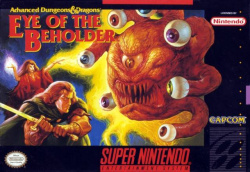 |
||||||
| ||||||
- For other games in the series, see Eye of the Beholder.
Eye of the Beholder is an action-adventure role-playing game developed and published by Capcom. It originally started life on MS-DOS and the Commodore Amiga by Westwood Studios in 1990, before arriving to the SNES just a few years later.
The city council of Waterdeep summons a group of heroes to deal with an evil that lies beneath the city. They are first sent to investigate the sewers of Waterdeep. However, at the heroes' entry, the entrance becomes barricaded, and so the heroes' journey begins.
The game is broken up into several screens. The top-left is a first-person view of what the party sees in front of them, and the player uses the cursor to interact with the environment. To the right of that is a portrait of each party member and the items they have in each hand. These are usually equipped with weapons, spellbooks, and holy symbols to combat enemies. Underneath the first-person view is a compass and directional arrows, the latter of which is used to move when clicked with the cursor. Alternatively, the player can use the D-pad to move as well. Underneath that is a text box, describing various things that happen in the game. On the bottom right is the Encamp button where the party can rest, memorize spells, and various game settings can be changed.
The SNES is a considerable downgrade from the DOS version, as the resolution had to be downscaled, making the interface more cramped. As a result, each party member's name is limited to just six characters. The SNES version also suffers the same fate as the NES version of Pool of Radiance, where Nintendo's censorship took effect; instead of praying for spells for clerics, they petition for spells. Spells like Bless have been renamed to Empower, Prayer became Meditation, and references to "death" are changed to "fear". The game allows the player to take advantage of the SNES mouse, but this means they must tediously click the directional arrows to move.
The SNES version of the game received mixed reviews. While some of the graphics did receive an upgrade, many criticized the game for running too sluggish, as well as the cramped screen resolution in comparison with the original computer versions.
Contents
Screenshots
Music
Eye of the Beholder received an upgrade in the audio department in comparison with the original computer versions. The songs from the computer versions composed by Paul Mudra are present here (save for the Westwood Associates Logo, which was replaced with the Capcom Logo jingle). The S-SMP chip of the SNES allows an upgrade in fidelity compared to the FM synthesis used in the original DOS version. However, this version also includes in-game music; something missing from the DOS original. Each major section has its own theme that is usually over a minute in length. The drawback is since you'll be spending a lot of time in each section, the songs can get annoying.
Due to the constant channel switching of instruments, it is most likely Tatsuya wrote MIDI files that were converted to the game's sound engine.
Recording
| # | Title | Composer | Arranger | Length | Listen | Download |
|---|---|---|---|---|---|---|
| 01 | Capcom Logo | Yasuaki Fujita | Yasuaki Fujita | 0:04 | Download | |
| 02 | The Prophecy | Paul Mudra | Tatsuya Nishimura | 1:40 | Download | |
| 03 | Birth of Heroes | Paul Mudra | Tatsuya Nishimura | 3:05 | Download | |
| 04 | Frightening Dungeon | Tatsuya Nishimura | Tatsuya Nishimura | 1:35 | Download | |
| 05 | Cold Stone Walls | Tatsuya Nishimura | Tatsuya Nishimura | 1:46 | Download | |
| 06 | Danger Lurks Ahead | Tatsuya Nishimura | Tatsuya Nishimura | 2:10 | Download | |
| 07 | Depths of the Earth | Tatsuya Nishimura | Tatsuya Nishimura | 1:36 | Download | |
| 08 | Nearing the End | Tatsuya Nishimura | Tatsuya Nishimura | 2:20 | Download | |
| 09 | Nearing the End (No Intro) | Tatsuya Nishimura | Tatsuya Nishimura | 2:18 | Download | |
| 10 | Final Battle | Tatsuya Nishimura | Tatsuya Nishimura | 2:18 | Download |
Credits
- Ripper: YK, Revenant
- Recorder: Doommaster1994
- Game Credits:
- Not Credited Capcom Jingle: Yasuaki Fujita
- Not Credited Composer: Paul Mudra
- Not Credited Composer: Tatsuya Nishimura
(No source; Game lacks credits.)
Neither the Japanese or North American releases of the game have credits. The original music in the game seems to fit the style of Tatsuya Nishimura, a composer for Capcom at the time, so it has been attributed to him. Capcom staff have verified that Yasuaki Fujita composed the Capcom Logo jingle, while Tatsuya Nishimura provided the instrument samples.
Game Rip
Audio Devices
The game uses the S-SMP of the SNES. It uses a custom audio driver that appears to be tied to First Circle. However, Harumi Fujita has denied working on this game.
Releases
Links
- Games Released In 1994
- Games Developed By Capcom
- No Amazon
- Games
- Eye of the Beholder (SNES)
- Games By Yasuaki Fujita
- Games By Paul Mudra
- Games By Tatsuya Nishimura
- Games Without Credits
- Games That Use SPC
- Games Released In Japan
- Super Nintendo Entertainment System Games
- Games Published By Capcom
- Games Released In USA
